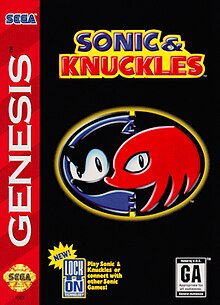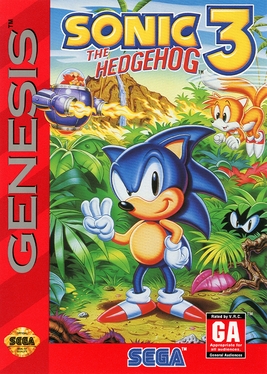
Sonic the Hedgehog 3 is a 1994 platform game developed and published by Sega for the Genesis. Like previous Sonic games, players traverse side-scrolling levels while collecting rings and defeating enemies. They control Sonic and Tails, who attempt to retrieve the Chaos Emeralds to stop Doctor Robotnik from relaunching his space station, the Death Egg, after it crash-lands on a mysterious floating island. Sonic 3 introduces Knuckles the Echidna, the island guardian, who lays traps for Sonic and Tails.
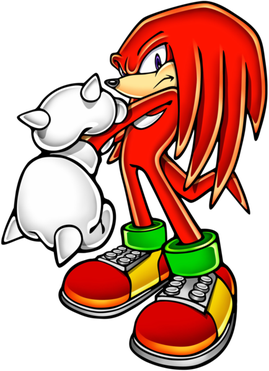
Knuckles the Echidna is a character from Sega's Sonic the Hedgehog series. He is a red anthropomorphic short-beaked echidna who is Sonic's secondary best friend and former rival. Determined and serious, but sometimes gullible, he fights his enemies using brute force and strength. His role is established as the guardian of the Master Emerald, a large gemstone which controls the series' integral Chaos Emeralds, and is the last living member of his tribe, the Knuckles clan.

Sonic Adventure is a 1998 platform game developed by Sonic Team and published by Sega for the Dreamcast. It was the first main Sonic the Hedgehog game to feature 3D gameplay. It follows Sonic the Hedgehog, Miles "Tails" Prower, Knuckles the Echidna, Amy Rose, Big the Cat, and E-102 Gamma in their quests to collect the Chaos Emeralds and stop Doctor Robotnik from unleashing Chaos, an ancient evil. Controlling one of the six characters—each with their own abilities—players complete levels to progress the story. Sonic Adventure retains many elements from prior Sonic games, such as power-ups and the ring-based health system. Players can play minigames such as racing and interact with Chao, a virtual pet.

Sonic Heroes is a 2003 platform game developed by Sonic Team USA and published by Sega as part of the Sonic the Hedgehog series. The player races a team of series characters through levels to amass rings, defeat robots, and collect the seven Chaos Emeralds needed to defeat Doctor Eggman. Within each level, the player switches between the team's three characters, who each have unique abilities, to overcome obstacles. Sonic Heroes downplays the action-adventure and exploration-based gameplay of its predecessors Sonic Adventure (1998) and Sonic Adventure 2 (2001) in favor of returning to the linear style of Sega Genesis-era Sonic games.

Miles Prower, better known by his nickname Tails, is a character from Sega's Sonic the Hedgehog series. Tails also appears in several spin-off games in which he stars, comic books, cartoons, and films. He is the first character to consistently appear by Sonic's side in the series as his best friend, appearing in nearly every mainline and spin-off since his debut. The name "Miles Prower" is a pun on "miles per hour", a reference to the famed speed of Sonic the Hedgehog. Prower is a two-tailed anthropomorphic fox, hence the nickname.

Sonic the Hedgehog is a 1991 platform game developed by Sonic Team and published by Sega for the Genesis/Mega Drive. It was released in North America on June 23 and in PAL regions and Japan the following month. Players control Sonic the Hedgehog, who can run at near supersonic speeds; Sonic sets out on a quest to defeat Dr. Robotnik, a scientist who has imprisoned animals in robots and seeks the powerful Chaos Emeralds. The gameplay involves collecting rings as a form of health, and a simple control scheme, with jumping and attacking controlled by a single button.
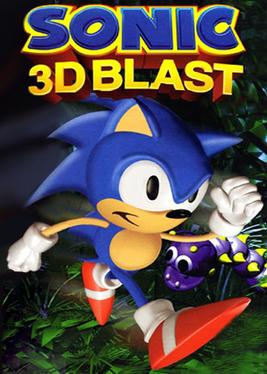
Sonic 3D Blast, known in Europe and Japan as Sonic 3D: Flickies' Island, is a 1996 platform game in the Sonic the Hedgehog series for the Sega Genesis and Sega Saturn. As Sonic the Hedgehog, the player embarks on a journey to save the Flickies, birds enslaved by Doctor Robotnik. The player must guide Sonic through a series of themed levels to collect Flickies and defeat Robotnik. Though it retains game mechanics from prior Sonic games, Sonic 3D Blast is differentiated by its 2D isometric perspective, with pre-rendered 3D models converted into sprites.

Knuckles' Chaotix is a 1995 platform game developed by Sega for the 32X. A spin-off from the Sonic the Hedgehog series, it features Knuckles the Echidna and four other characters known as the Chaotix, who must prevent Doctor Robotnik and Metal Sonic from obtaining six magic rings and conquering a mysterious island. Gameplay is similar to previous Sonic games: players complete levels while collecting rings and defeating enemies. Knuckles' Chaotix introduces a partner system whereby the player is connected to another character via a tether; the tether behaves like a rubber band and must be used to maneuver the characters.

Sonic Blast is a 1996 side-scrolling platform video game known for its use of pre-rendered visuals. To stop Doctor Robotnik from using Chaos Emerald shards to fortify his base, the player controls Sonic the Hedgehog and Knuckles the Echidna through 15 levels. As a Sonic the Hedgehog series platformer, the characters run and jump to reach the end of a level while defeating enemy robots and collecting rings. In separate bonus stages, the player must run forward and collect rings to earn one of the Chaos Emerald shards.

Sonic the Hedgehog Spinball, also known as Sonic Spinball, is a 1993 pinball video game developed by Sega Technical Institute and published by Sega. It is a spinoff of the Sonic the Hedgehog series. Players control Sonic the Hedgehog, who must stop Doctor Robotnik from enslaving the population in a giant pinball-like mechanism. The game is set in a series of pinball machine-like environments with Sonic acting as the pinball.

Sonic the Hedgehog: Triple Trouble is a 1994 platform game developed by Aspect and published by Sega for the Game Gear. It is the sequel to Sonic Chaos (1993) and features classic side-scrolling Sonic gameplay. The player controls either Sonic the Hedgehog or Miles "Tails" Prower as they venture to protect the powerful Chaos Emeralds from Doctor Robotnik, Knuckles the Echidna, and series newcomer Nack the Weasel. Sonic and Tails' unique abilities, as well as various power-ups, can assist the player in gameplay.
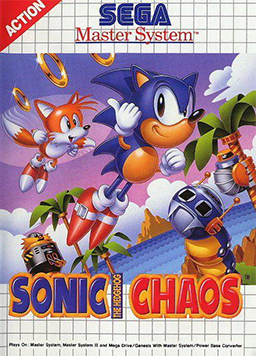
Sonic Chaos is a 1993 platform game published by Sega for the Master System and Game Gear. Players control Sonic the Hedgehog and his sidekick Miles "Tails" Prower in their quest to retrieve the Chaos Emeralds from Doctor Robotnik, who has stolen them to construct nuclear weapons. Gameplay involves running through stages, collecting rings, and defeating enemies. It is largely based on the Master System version of Sonic the Hedgehog 2, and is thus considered a follow-up to that game. Chaos is the first Sonic game for the Master System and Game Gear to feature Tails as a separate playable character with his own unique abilities.

Sonic the Hedgehog 2 is a 1992 platform game developed by Aspect and published by Sega for the Master System and Game Gear. It is the sequel to the 8-bit Sonic the Hedgehog (1991) and follows Sonic as he attempts to get the Chaos Emeralds back to rescue his friend Miles "Tails" Prower from Dr. Robotnik. Like the first Sonic the Hedgehog, players run through levels at high speeds while collecting rings and defeating enemies. Although it shares the same title with Sonic the Hedgehog 2 for the Sega Genesis and their releases coincided, the games have little in common and share no levels.

Sonic the Hedgehog is a video game series and media franchise created by the Japanese developers Yuji Naka, Naoto Ohshima, and Hirokazu Yasuhara for Sega. The franchise follows Sonic, an anthropomorphic blue hedgehog who battles the evil Doctor Eggman, a mad scientist. The main Sonic the Hedgehog games are platformers mostly developed by Sonic Team; other games, developed by various studios, include spin-offs in the racing, fighting, party and sports genres. The franchise also incorporates printed media, animations, feature films, and merchandise.

Sonic the Hedgehog 2 is a 1992 platform game developed by Sega Technical Institute (STI) for the Sega Genesis. Players control Sonic as he attempts to stop Doctor Robotnik from stealing the Chaos Emeralds to power his space station. Like the first Sonic the Hedgehog (1991), players traverse side-scrolling levels at high speeds while collecting rings, defeating enemies, and fighting bosses. Sonic 2 introduces Sonic's sidekick Miles "Tails" Prower and features faster gameplay, larger levels, a multiplayer mode, and special stages featuring pre-rendered 3D graphics.

Doctor Ivo"Eggman"Robotnik is the main antagonist of Sega's Sonic the Hedgehog franchise. Eggman was created and designed by Naoto Ohshima as part of many design choices for Sega's new mascot. After the creation of Sonic the Hedgehog, Ohshima chose to use his previous egg-shaped character to create the antagonist of the 1991 video game Sonic the Hedgehog, making him the arch-nemesis of the series' eponymous main character.

Sonic the Hedgehog 4: Episode I is a 2010 platform game developed by Dimps, with assistance from Sonic Team, and published by Sega. It is a sequel to Sonic & Knuckles (1994), following Sonic as he sets out to stop a returning Doctor Eggman. Like the Sonic the Hedgehog games released for the Sega Genesis, Episode I features side-scrolling gameplay, with movement restricted to a 2D plane. The player races through levels collecting rings while rolling into a ball to attack enemies. The game also features special stages in which the player collects Chaos Emeralds and online leaderboards comparing level completion times and high scores.

Sonic Mania is a 2017 platform game published by Sega for Nintendo Switch, PlayStation 4, Xbox One, and Windows. Produced in commemoration of the Sonic the Hedgehog series' 25th anniversary, Sonic Mania pays homage to the original Sega Genesis Sonic games, featuring speedy side-scrolling gameplay. It takes place over 13 levels, including several redesigned from past games. The story follows Sonic, Tails and Knuckles as they venture to defeat their nemesis Doctor Eggman and his robotic henchmen, the Hard-Boiled Heavies.

Sonic Classic Collection is a 2010 video game compilation developed by Creative Assembly and published by Sega exclusively for the Nintendo DS. It contains the four main Sonic the Hedgehog platform games originally released for the Sega Genesis: Sonic the Hedgehog (1991), Sonic the Hedgehog 2 (1992), Sonic the Hedgehog 3 (1994), and Sonic & Knuckles (1994). Upon release, Sonic Classic Collection received mixed reviews.

Sonic Origins is a 2022 video game compilation. It features remasters of the first four platform games in Sega's Sonic the Hedgehog series—Sonic the Hedgehog (1991), Sonic the Hedgehog 2 (1992), Sonic CD (1993), and Sonic the Hedgehog 3 & Knuckles (1994)—originally released for the Sega Genesis and the Sega CD. The games are playable in their original format and a new widescreen format that removes lives. Origins adds additional game modes and missions, which allow players to unlock content in a museum.
